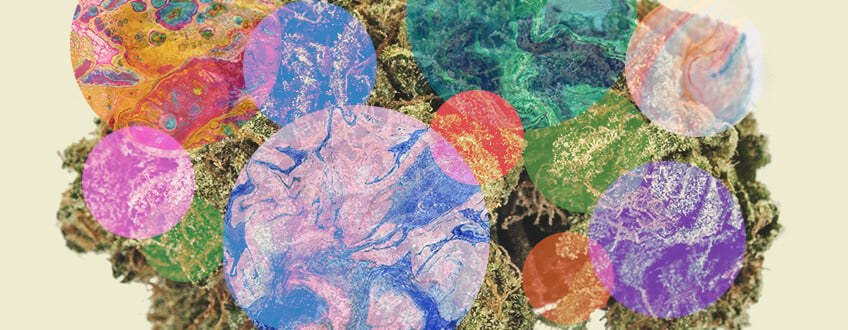.

What Is TAC (Total Active Cannabinoids) in Cannabis?
Ever wondered why different strains of cannabis have different effects? It's not just the amount of THC inside. All of the active compounds in cannabis come together to produce unique effects based on their ratios. These ratios are expressed as the "TAC". Find out what this means for both medical and recreational weed users.
Contents:
There’s more to weed than just THC. In fact, there’s more to weed than just cannabinoids. The effects one feels from using cannabis, whether smoked, vaped, or ingested by some other means, are the result of an intricate dance between a host of compounds with synergistic relationships. However, many of these compounds are poorly understood.
Still, if buying cannabis legally (or, who knows, from the best dealer ever), the total active cannabinoids (TAC) should be displayed on the cannabis label. If you know what sort of high you like, then honing in on strains or products with your favourite compounds is a great way to maximise your experience. It becomes even more important for those who consider themselves medical users, as certain compounds and ratios may be more suited to soothing specific symptoms than others.
Ultimately, regardless of what type of cannabis user you are, knowing the TAC of your product can massively improve your experience.
What Is TAC?
TAC, in weed terminology, refers to total active cannabinoids—the amount of detectable cannabinoids in a cannabis product that will, in some way, affect its high or overall effects. This synergistic relationship is known as the entourage effect. Sometimes expressed in the context of TAC vs THC, the two are not in opposition, but rather enhance each other.
The entourage effect is currently little-understood, to the extent that its existence is not even certain. However, research indicates that it is probably a real phenomenon.
In any case, it is speculated that the myriad cannabinoids (and other compounds) in certain strains work together to determine the final effects. It is not as simple as X amount of THC equals Y high. In the most well-known example of the entourage effect, CBD has been shown to counteract some of the psychotropic effects of THC. So, by moving closer to a 1:1 CBD to THC ratio, the negative effects of THC—such as paranoia and a racing heart—may be reduced.
This is but one example involving only two cannabinoids, but there could be a huge number of different molecules interacting directly and indirectly within the body to influence the overall effect.

TAC (Total Active Cannabinoids) vs TAC (Total Aerobic Count)
In regard to cannabis, TAC can also refer to the “total aerobic count”. This is the industry term—across all of agriculture—used to describe the total microbial content of a product.
In commercial cannabis operations, breeders often have to submit their cannabis for TAC testing before it goes to market. However, it is not a particularly illuminating practice, and is of limited use.
Though it can tell you what the microbial count is, total aerobic count can't give an indication of whether those microbes are pathogenic or beneficial. For instance, many cannabis growers use Bacillus subtilis, an organic bacterial fungicide, to protect their plants. Consequently, the final product could have a high TAC count despite posing no health risks to end users. Likewise, a low TAC count does not indicate a low presence of pathogenic microbes.
To buyers, though, this is of little concern, as the total aerobic count is unlikely to be advertised on the final product. The total active cannabinoids, however, may well be.
What Cannabinoids Are in Weed?
There are 113 known cannabinoids produced in the cannabis plant. Technically, these are called phytocannabinoids—with “phyto” relating to plants.
Of these 113 phytocannabinoids, the two most abundant (and famous) are delta-9-tetrahydrocannabinol (THC) and cannabidiol (CBD). There are, however, far, far more. The first cannabinoid to form in the cannabis plant is cannabigerolic acid (CBGA). It is from CBGA that all other cannabinoids are produced.
Although the body of research is very limited in this context, there are certain ancillary cannabinoids that have caught the attention of researchers and cannabis users:
| Tetrahydrocannabinolic acid (THCA) | This is the precursor to THC, which must go through decarboxylation (heating) to become active. Much of this happens when cannabis is smoked, vaped, or otherwise sufficiently heated. |
| Cannabinol (CBN) | When THC degrades, it becomes CBN. Research is being conducted into CBN’s potential effects on sleep. |
| Cannabichromene (CBC) | This is not as well-understood as some other cannabinoids. However, it seems to have a strong affinity for CB2 receptors, whereas THC has a greater affinity for CB1 receptors. Research suggests that combining the two may result in more comprehensive outcomes via the entourage effect. |
| Cannabidivarin (CBDV) | This compound is not so abundant in most commercially available strains of cannabis, but is more common in wild indica landraces found in Central Asia. It has a similar chemical structure to CBD, and is thought to offer similar effects. |
| Tetrahydrocannabinolic acid (THCA) |
| This is the precursor to THC, which must go through decarboxylation (heating) to become active. Much of this happens when cannabis is smoked, vaped, or otherwise sufficiently heated. |
| Cannabinol (CBN) |
| When THC degrades, it becomes CBN. Research is being conducted into CBN’s potential effects on sleep[3]. |
| Cannabichromene (CBC) |
| This is not as well-understood as some other cannabinoids. However, it seems to have a strong affinity for CB2 receptors, whereas THC has a greater affinity for CB1 receptors. Research suggests that combining the two may result in more comprehensive outcomes via the entourage effect. |
| Cannabidivarin (CBDV) |
| This compound is not so abundant in most commercially available strains of cannabis, but is more common in wild indica landraces found in Central Asia. It has a similar chemical structure to CBD, and is thought to offer similar effects. |
Other Notable Compounds in Cannabis
Cannabinoids are not the only compounds that play a part in the entourage effect. Terpenes, flavonoids, and fatty acids all take active roles as well.
This may come as a surprise, but, in fact, the effects of most drugs can be significantly altered by inhibiting one enzyme or producing more of a certain neurotransmitter, for example.
Take ayahuasca for example. The active ingredient—that which causes the high—is DMT. However, DMT cannot usually reach the brain due to the presence of monoamine oxidase (MAO), an enzyme. Yet, part of the ayahuasca mixture contains an MAO inhibitor. By suppressing that enzyme, the body is able to digest DMT in such a way that it crosses the blood–brain barrier.
That is but one example of how something with no psychoactive effects can be an essential piece of the overall psychotropic puzzle.
-
Terpenes
Terpenes are the compounds that give cannabis its distinctive scents and flavours. These aromatic molecules are not only found in the cannabis plant, though. On the contrary, they are found in most plants, and ultimately make their way into essential oils and a host of other pleasant-smelling products. Aside from the dank smell of cannabis, terpenes are responsible for the scents of a pine forest, the aroma of lemons, rosemary, and so on.
It was once thought that terpenes affected people by their smell alone, and that different smells had mild effects on mood. It is now known that certain terpenes interact with the body directly, including via the endocannabinoid system. Beta-caryophyllene, for example, activates CB2 receptors in the immune system.
There are hundreds of terpenes, but some of the most prevalent in cannabis include:
| Pinene | As the name suggests, pinene gives off that woody scent of sap and pine. It is thought to be one of the more energising terpenes. |
| Linalool | Gives off a floral scent and produces a soothing effect; also found in lavender. |
| Limonene | If you’ve smelled much weed, you know the uplifting scent of limonene. This, as the name suggests, is the terpene that gives cannabis that powerful, citric tang. |
| Eucalyptol | Gives off the same fresh scent as eucalyptus and works as an antioxidant. |
| Pinene | As the name suggests, pinene gives off that woody scent of sap and pine. It is thought to be one of the more energising terpenes. |
| Linalool | Gives off a floral scent and produces a soothing effect; also found in lavender. |
| Limonene | If you’ve smelled much weed, you know the uplifting scent of limonene. This, as the name suggests, is the terpene that gives cannabis that powerful, citric tang. |
| Eucalyptol | Gives off the same fresh scent as eucalyptus and works as an antioxidant. |
-
Flavonoids
Flavonoids are found in most plants, where they tend to play the role of pigments. When consumed in food, they have antioxidant effects and a host of other benefits. However, they are little-understood in terms of cannabis, and smoking specifically. Eating something is very different to combusting it!
That said, it appears flavonoids interact with the endocannabinoid system to some degree. If this is the case, then although it may be too early to say exactly what influence flavonoids have on the entourage effect, it is highly likely they do affect the process.
-
Fatty Acids
There are a host of fatty acids found in cannabis. Again, they have been little-studied, but preliminary research suggests that they too can interact with the endocannabinoid system. By facilitating the binding of 2-AG to the CB1 and CB2 receptors, they are thought to play a potential role in the entourage effect.
TAC in Weed: The Takeaway
So, it’s clear that the overall effects of cannabis aren’t just dictated by two powerful cannabinoids. Whether you’re getting high or enjoying a non-psychotropic form of cannabis, there are potentially hundreds of different molecules working to fine-tune your experience.
Of what use is this to you? Well, if you’re able to determine the TAC of cannabis strains/products before buying, you'll be more equipped to achieved the desired effect, and limit any effects you don’t fancy.
Of course, even if you live somewhere where cannabis is legal and manufacturers list the TAC, it’s still not going to tell you every compound in there. But it should break down the major cannabinoids, and maybe even some terpenes too.
Going forward, it’s likely we’ll discover more about the roles different compounds play. In fact, that’s exactly what we’re doing at RQS. RQS Pro is a new initiative that has set out to perform cutting-edge research into cannabis and its components. In time, we will come to have a greater understanding of all their different functions, and how best to harness them. By understanding the different compounds in cannabis, we'll eventually be able to breed an incredible array of strains with tailored ratios. Whatever you want, we'll likely have it.
- The Case for the Entourage Effect and Conventional Breeding of Clinical Cannabis: No "Strain," No Gain - PubMed https://pubmed.ncbi.nlm.nih.gov
- A tale of two cannabinoids: the therapeutic rationale for combining tetrahydrocannabinol and cannabidiol - PubMed https://pubmed.ncbi.nlm.nih.gov
- Synthesis and pharmacological effects in mice of halogenated cannabinol derivatives - PubMed https://pubmed.ncbi.nlm.nih.gov
- Cannabichromene is a cannabinoid CB 2 receptor agonist - PubMed https://pubmed.ncbi.nlm.nih.gov
- Interactions of flavonoids and other phytochemicals with adenosine receptors - PubMed https://pubmed.ncbi.nlm.nih.gov
- An entourage effect: inactive endogenous fatty acid glycerol esters enhance 2-arachidonoyl-glycerol cannabinoid activity - PubMed https://pubmed.ncbi.nlm.nih.gov








































